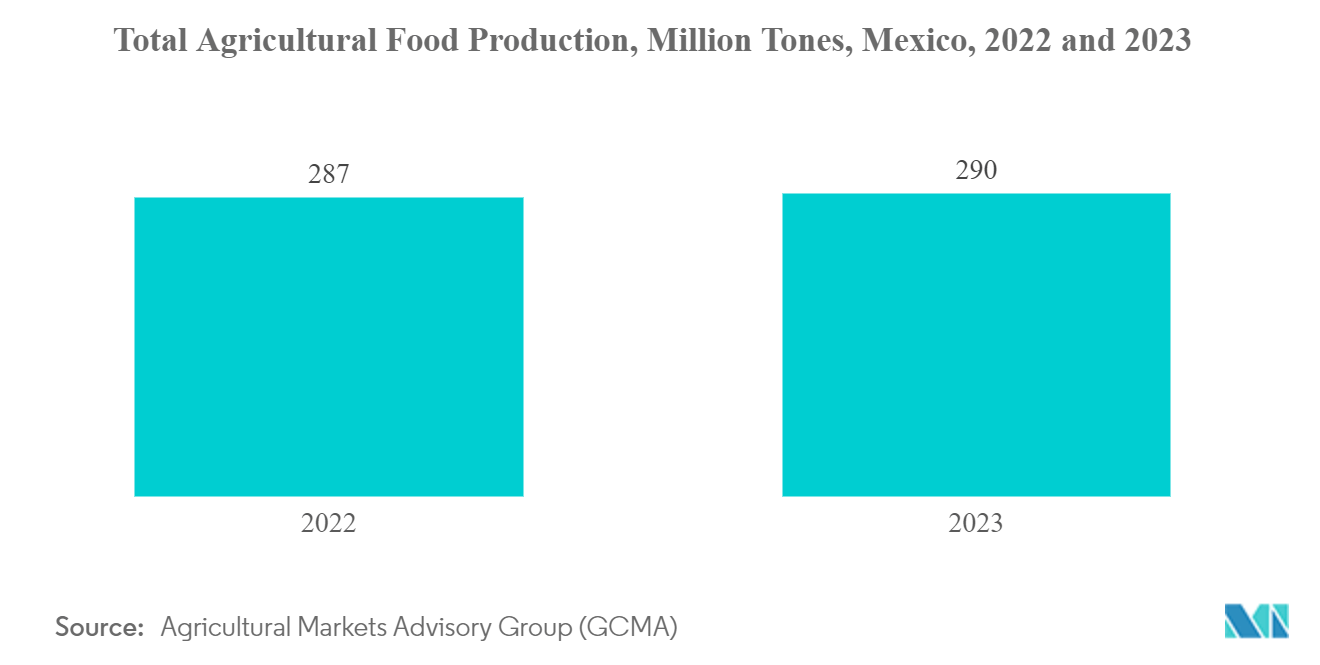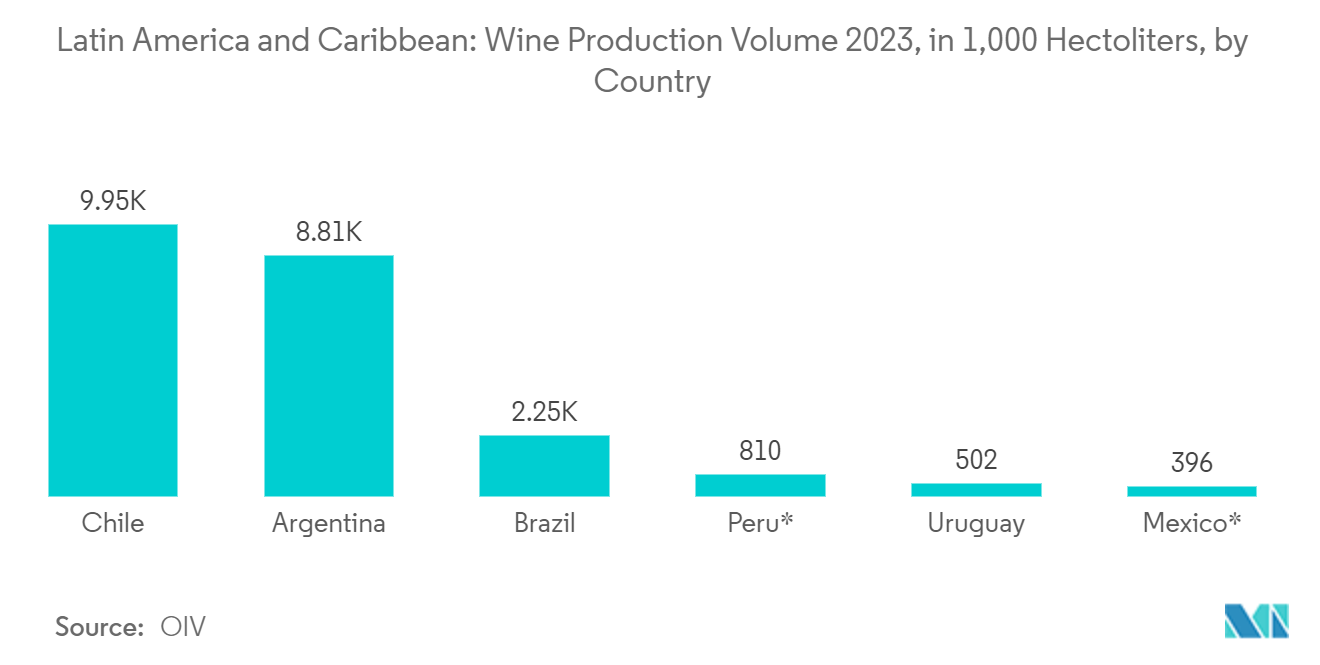Market Trends of Latin America Rigid Bulk Packaging Industry
Robust Food and Beverage Production Aids the Market
- The food industry in Latin America is changing to meet the population's needs. Agricultural output in Latin America and the Caribbean has increased significantly over the past 10 years. The region has one-third of the world's freshwater resources and more than one-fifth of medium to high-potential worldwide farmland. Latin America and the Caribbean as a whole are already the biggest net food exporters in the world.
- Latin America and the Caribbean agricultural production is expected to grow by 14% in the next decade, according to the latest report from the United Nations Food and Agriculture Organization (OECD-FAO). According to the report, 64% of this increase would be attributable to crop production, and 28% would come from the livestock sector. Therefore, there would be a strong demand for plastic and steel drums for the agriculture and farming industries for storing agricultural produce and fertilizers.
- The region will continue to be the world's biggest producer of soybeans, with 53% of global production projected by 2031. While the region's share in global cereal production is lower, its share in maize production is expected to increase by nearly 18% by 2031. Yield increases are projected to continue, with an average yield increase of about 10% by 2031 across most major crop commodities.
- According to a report by the OECD-FAO in May 2022, the region is projected to represent 18% of world food exports by 2031. With strong supply growth, the region is set to strengthen its position as an exporter. By 2031, soybeans, sugar, fish meal, maize, beef, and fish oils would represent 61% of world exports. The level of trade openness in the region would have a major impact on the sector and global food security. This export trade would bolster the market for bulk containers with tracking and tracing applications.
- Further, as per the report published by the Agricultural Markets Advisory Group (GCMA) in March 2023, Mexico would rank 10th on the list of the largest food producers in the world in 2023. According to GCMA's agri-food perspectives 2023 report, Mexico's total food production is expected to reach 290 million tonnes in 2023, which is higher than the 287 million tonnes reported in 2022. This includes the production of grains and oilseeds, as well as fruits and vegetables, livestock, and processed products. This growth is expected to be witnessed in the forecast period, proportionately driving the market for rigid bulk drums and containers across the country.

Brazil is Expected To Hold a Significant Market Share
- Brazil is one of the top Latin American nations for economic growth and foreign direct investment and attained an economic growth of USD 4244.21 million in July 2023 (Trading Economics). Plastics make up over 40% of Brazil's most prominent packaging industry, according to a survey on Brazilian Plastic Packaging conducted in June 2022 by Biointerface Research in Applied Chemistry. Plastic manufacturing volume climbed by 6.8% when broken down by grade. The immense demand from the industrial packaging sector globally drives this trend.
- As reported by OIV, Brazil's wine production of approximately 2.25 million hectoliters is expected to drive market growth.
- Brazil's landscape of rigid bulk packaging is changing. The product product manufacturers are increasingly pressuring packaging suppliers to create eco-friendly designs. As a result, more and more rigid packaging alternatives are emerging with less weight and higher biodegradability. According to a survey conducted by Russell Publishing in March 2022, a new edible, biodegradable, and antibacterial substance was discovered in Brazil to combat the proliferation of single-use plastic waste. Research on environmentally friendly packaging, including edible, biodegradable, and antimicrobial polymers, is being driven by growing worries about plastic waste.
- Brazil is forecasted to be one of the fastest-growing beer markets, and the market demand is anticipated to increase in the forecast period as well. To meet the growing demand for premium and craft beers, currently led by the brands Heineken and Baden Baden, the company invested in the modernization of its production units in Sao Paulo, which includes increasing the production capacity of Heineken at the Araraquara brewery. In February 2022, Heineken invested USD 64 million in the Brazilian state of São Paulo, the company informed during a press conference with São Paulo's Governor João Doria. Therefore, this kind of expansion and investments from several big brands may bolster the need for rigid bulk containers, drums, and barrels.
- Notably, Brazil is one of the significant contributors to the market share in Latin America. The country is a mature market in the pharmaceutical industry in the region. The market in the country witnessed various product innovations, especially pharmaceutical packaging products, owing to significant vendors across the country. The region's expanding pharmaceutical production, the increased availability of over-the-counter medicines, and significant investments made by local businesses all contribute to the enormous growth of the Brazilian pharmaceutical sector. These trends would lead to an upsurge in pharmaceutical rigid bulk packaging demand nationwide.
- According to the United Nations' COMTRADE database, Brazil's pharmaceutical exports amounted to USD 1.43 billion in 2022. In 2022, the United States accounted for the largest share of Brazil's pharmaceutical exports, with a value of almost USD 196 million. Intermediate Bulk Containers (IBC) are widely used for pharmaceutical exports. The bulk containers not only help in safe storage but also ensure proper dispensing and reduce pharmaceutical wastage.


